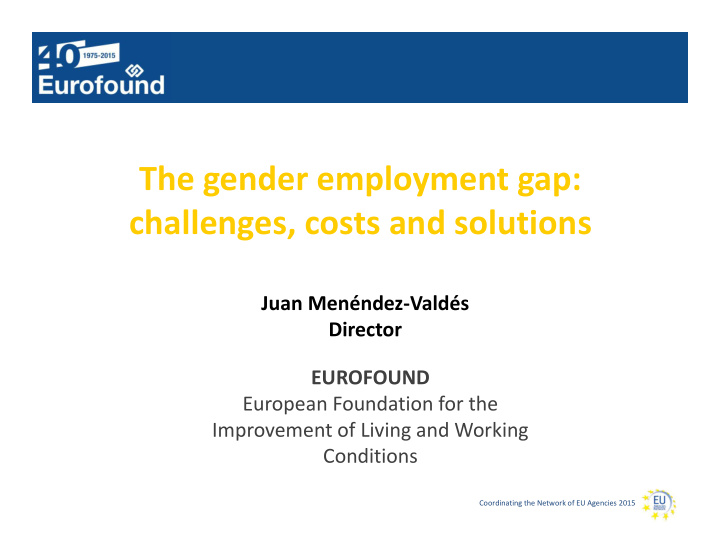



The gender employment gap: challenges, costs and solutions Juan Menéndez-Valdés Director EUROFOUND European Foundation for the Improvement of Living and Working Conditions Coordinating the Network of EU Agencies 2015
• With the prospect of a shrinking working-age population, increasing the labour-force participation and raising the employment rate of women is of paramount importance for Europe. • Economic independence enables both women and men to exercise control over their lives and plan their families. • Equality between women and men is not only a question of fairness, but also an economic objective. In fact, increasing women employment is crucial to ensure that the EU can achieve its goals set out in the Europe 2020 Strategy: smart, sustainable and inclusive growth. Coordinating the Network of EU Agencies 2015
While the employment rate for men (aged 15-64) was 70.1% in 2014 in EU28, for women it was only 59.6% during that year. The labour market participation of women varies considerably among Member States, varying from 41.1% of Greece to 73.1% of Sweden Coordinating the Network of EU Agencies 2015
A gender employment gap is recorded in all Member States. The magnitude of this gap varies from 1.5% of Finland to 25.6% of Malta. Coordinating the Network of EU Agencies 2015
At European level, the gender employment gap increase with age and is larger for the range of 30-40 years old. It declines for the ages of 40-55 and then it increases again for 55-64. Different situation between Member States Sweden vs Italy How much is the cost of the gender employment gap? Coordinating the Network of EU Agencies 2015
How much does this differential among the employment rates of men and women cost each year? Estimating the potential income of non working women on the basis of education, age and other socio demographic characteristics Foregone Earnings and Excess of welfare unpaid taxes transfer ≈ € 325,000,000,000 ≈ 2.5% of EU GDP Source: Eurofound Coordinating the Network of EU Agencies 2015
The extent of the economic loss varies among the various Member States depends on the size of the gender employment gap Finland Sweden <1% ….. Italy Greece Malta Slovakia > 5% Coordinating the Network of EU Agencies 2015
How much is the cost for society of the lifelong exclusion of a young women from the labour market? 35000 Per young woman with ISCED 4 or less who never entered the 30000 labour market: 25000 735,000 Euro 20000 ISCED 4 or less 15000 ISCED 5 - 6 Per young woman with ISCED 5- 10000 6 or less who never entered the 5000 labour market: 0 1,150,000 Euro 20-34 35-49 50-64 Coordinating the Network of EU Agencies 2015
It is not just the extent of participation, but also its quality • Working time: One third of women in the labour market are working part- time against the 8.8% of men. 41 hours per week 34 hours per week 16% would like to spent at work spent at work work more • Gender segregation at sectorial level Construction 91% male Health 77% female Transport 80% male Industry 69% male Education 67% female Agriculture 65% male • Unadjusted Pay Gap: For the economy as a whole, women's gross hourly earnings were on average 16.4 % below those of men in 2013 in the European Union. Coordinating the Network of EU Agencies 2015
However, not all women will be available or willing to work. Women’s labour market conditions are largely affected by the unequal division of family responsibilities in the household. 39 hours of unpaid domestic • work for employed women, 26 hours for employed men. The employment rate of • women aged 20-49 with children under twelve is 67% compared with 78.5% for women of the same age without children The freedom of choice Coordinating the Network of EU Agencies 2015
Next steps • Increasing the labour-force participation and raising the employment rate of women is of paramount importance for Europe, for the individual and for the society. • The current gender employment gap is costing Europe more than 300 billion Euro a year and the cost of lifelong exclusion is above 1 million Euro per individual. • The value of non-paid work and its beneficial effects for society should be considered in order to better contextualise the results. This comparison will be performed in the final version of this project. • The impact on economic growth of an increasing female labour market participation in the medium term will be estimated in the final step of the project which will be completed in Autumn 2015 Coordinating the Network of EU Agencies 2015
To conclude • Policies to ensure flexible working hours , to reduce segregation in labour market and to facilitate work–life balance for working parents should be supported to promote a wider female labour market participation. • Sharing the burden of family responsibility and domestic activities between men and women and the availability of affordable childcare services and facilities will ease the participation of women to the labour market. A greater focus on men and fathers in gender equality policies would help a redistribution of tasks and households responsibilities. • All these initiatives will contribute to guarantee a greater freedom of choice of women in respect to their participation in the labour market. Coordinating the Network of EU Agencies 2015
Thanks! Coordinating the Network of EU Agencies 2015
Recommend
More recommend